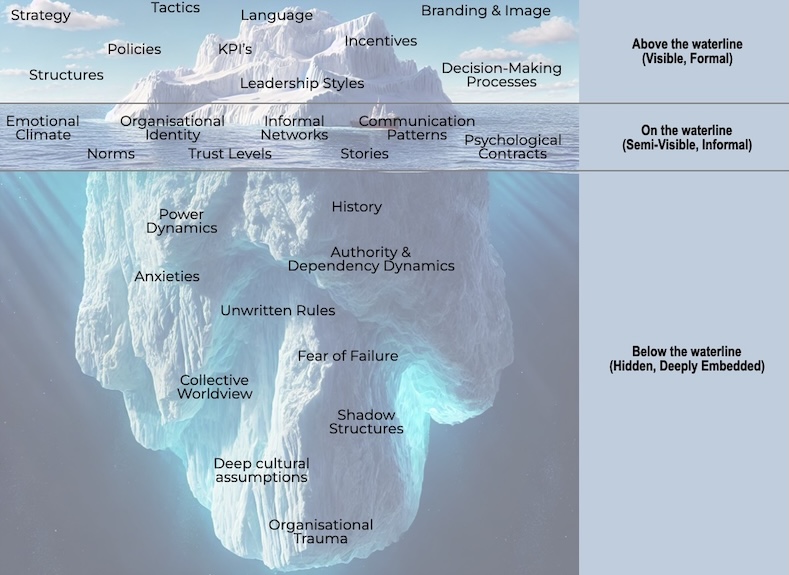Surface Tension
What invisible force holds your organisation together—and might suddenly tear it apart?
This is part 1 of a 10 part series
Beneath the smooth surface facade of every thriving company lies a hidden interplay of forces that few leaders perceive and even fewer engage with. Leaders who master these forces significantly strengthen their organisations, while those who don't are like surgeons operating without knowing the patient's complete medical history—every decision carries unseen risks.
Just as a water droplet defies gravity through surface tension, organisations maintain their structure through psychological tensions—unseen yet powerful forces that hold people, culture, and strategy together. In water, surface tension allows droplets to resist external pressure, flexing without breaking. Likewise, in organisations, the interplay of competing priorities, unspoken norms, and shared beliefs creates a kind of psychological surface tension that shapes resilience.
Acknowledging and managing these tensions enables adaptability, allowing the organisation to flex and withstand pressure without losing coherence. However, when overlooked, they become points of fragility, leading to fragmentation, internal conflict, or collapse under stress. Like stable droplets, resilient organisations don't eliminate tension; they master it.
Powerful yet unseen surface tensions determine whether brilliant strategies succeed or mysteriously fail. Daily, executives make consequential decisions without recognising the hidden currents shaping their choices and their organisation's response.

The most successful leaders intuitively sense these forces. They navigate the surface tension that others stumble through blindly, recognising that organisational equilibrium depends on elements rarely discussed in boardrooms: collective anxieties, deep cultural assumptions, unwritten rules, power dynamics and more.
When I entered the coaching world in 2002, I discovered something extraordinary: these invisible dynamics could be made visible.
There is a dizzying array of models and theories that coaches and consultants will attempt to apply to businesses. My clients—primarily business leaders with little formal psychology background—need more than elegant theories; however, they require practical tools that deliver tangible results. Over the years, I have sorted through which approaches work in the real world.
"In theory, there is no difference between theory and practice.
In practice, there is." - Yogi Berra
.
Yogi Berra's famous quip captures the chasm I've observed between elegant psychological frameworks and their messy application in boardrooms and team meetings. My previous article, Beneath the surface: What You Can't See Is Running the Show , opened up numerous conversations online and in person. The one question I got asked a lot went along the lines of "How do we see better below the surface?"
With this in mind, I want to translate the unconscious forces I explored into the battle-tested strategies that I have learned and that you can implement in your business.
Why? Firstly, I want to make sense of it myself. Much of my learning happens 'in the moment', one idea building on another, one process adapted from an earlier one, and an experience in one context adapted to a new environment. By writing it down, I capture my learning and make my approaches explicit.
Secondly, my ideas may spark ideas and builds for you or someone you share them with. This is valuable as it opens up opportunities for more learning.
Introduction: The psychology behind your strategy
In today's boardrooms, executives discuss metrics, markets, KPIs, and priorities. The invisible psychological currents running beneath these conversations remain conspicuously absent.
Unacknowledged fears, group dynamics, and unconscious defences ultimately determine whether any strategy succeeds or fails. These forces aren't abstract concepts—they're as real as balance sheets and quarterly targets.
A quick scan of recent news turns up headlines such as "Kohl's CEO Reveals Its 'Shortsighted' Decisions Will Be Reversed" - The Sun, 2024, "At Boeing and Starbucks, Different Problems but Similar CEO Messages" - Sloane PR , 2024 or "Intel's New CEO Plots Overhaul of Manufacturing and AI Operations" - Reuters , March 17, 2025.
These undercurrents explain why organisations consistently behave in ways that contradict their stated intentions. When transformation programmes stall, teams fail to collaborate, and brilliant strategies deliver disappointing results, the culprit is usually not poor planning. It is these invisible dynamics at work.
When turning around Ford, Alan Mulally perfectly captures this tension when he says: "You can't manage a secret." His focus wasn't just financial metrics but creating psychological transparency where problems could be surfaced and addressed. Similarly, Microsoft's Satya Nadella emphasised that "The C in CEO stands for culture. The CEO is the curator of the organisation's culture."
Both these leaders recognise that beneath rational strategies lie psychological realities that ultimately determine success. Leaders who learn to navigate these waters gain a profound competitive advantage—those who don't find themselves perpetually mystified by their organisation's resistance to seemingly rational changes.
Here are eight tangible strategies for actively engaging with and shifting the psychological forces that lurk beneath every organisation.
TLDR;
Eight practical strategies for harnessing the unconscious in your organisation.
- Develop X-ray vision : Learn to see beneath surface behaviours to identify patterns that reveal the system's unconscious dynamics. Leaders like Alan Mulally at Ford created spaces to make problems visible, transforming a culture of denial into one of transparency.
- Create containers for anxiety : These structured forums productively metabolise anxiety rather than destructively act it out. Pixar's "Braintrust" demonstrates how properly containing anxiety fuels creativity instead of paralysing it.
- Move beyond team-building workshops : Address unconscious role assignments and power dynamics rather than focusing only on skill development. Microsoft's shift from a "know-it-all" to a "learn-it-all" culture tackled these dynamics directly.
- Build in reflection : Institute deliberate pauses to develop organisational intelligence. Companies like Bridgewater use structured reflection to examine what happened and the mental models that produced decisions.
- Master polarity thinking : Treat persistent tensions as polarities to manage rather than problems to solve. Johnson & Johnson and other international organisations balance global standardisation with local responsiveness, demonstrating this sophisticated approach.
- Lead by being, not just doing : Develop your leadership consciousness to work with unconscious forces rather than against them. This requires cultivating the capacity to observe the system while participating in it.
- The hot seat : Create a private, high-value, facilitated conversation among your executive team in which they give developmental feedback to each other, probably more candidly than ever before.
- Make leadership explicit : CCL's Direction Alignment Commitment model is a simple and accessible tool for evaluating your organisation's leadership quality. It works on the premise that leadership happens throughout your organisation. DAC can give you an immediate view of how to strengthen leadership.
Conclusion
When implemented together, these eight strategies create a systemic approach to working with unconscious forces in organisations. Rather than treating them as separate initiatives, they form an integrated practice where each reinforces the others. See how they all fit together and review the body of work on which my thinking is based.
